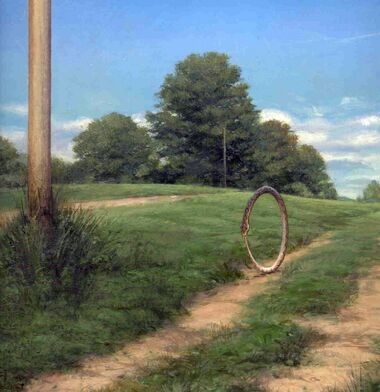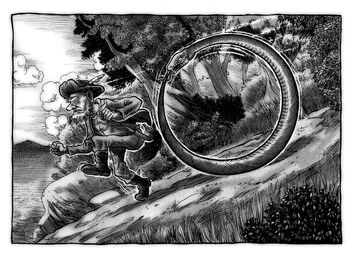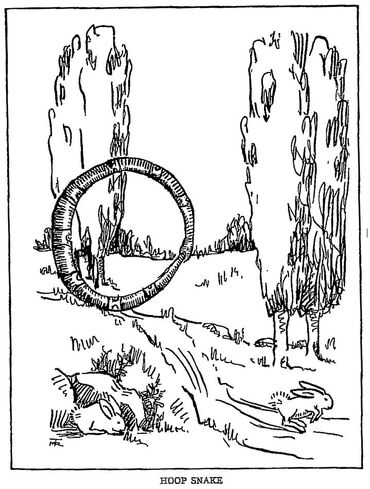
The tail ends in a stinger carrying venom of such power that a dose of but 0.003 p.p.m. is sufficient to make even the leather-skinned Hodag turn green and swell up and die inside of an hour. No wonder that folks wise in woods lore are wary of this circular engine of destruction. He may travel on just one cylinder but that’s all he needs.
The speed reached in rolling is nothing short of remarkable. A full grown jack-rabbit is pie for this Snake. A mature Snake, when hooped, has a diameter of 1.5923 feet. He has been clocked, after being enticed on to a cleverly designed rolling metered platform at an r.p.m. of about 1056, or a straightaway speed of some 60 m.p.h. The only way to outrur him is to climb Over a fence. The Snake must unhoop to get through.

There are many authentic cases of death from this reptile’s venom; possibly the most convincing bit of data is that, in a fit of pique, a Hoop Snake stung one of Paul Bunyan’s peavy handles. Of course this handle was a sizeable stick to start with, but the venom swelled it to such dimensions that Paul cut it up into 946 cords of wood. And then the dang stuff wouldn’t burn. Just lay in the stove and hissed.
The hoop snake is a legendary creature of the United States, Canada and Australia.[1] The hoop snake appears in the Pecos Billstories; although it is his description of hoop snakes with which most people are most familiar, stories of the creature pre-date those fictional tales considerably. Several sightings of the hoop snake have been alleged along the Minnesota-Wisconsin border in the St. Croix River valley and in Wake County in North Carolina and in Kamloops, British Columbia.

According to folklore, the distinguishing feature of a hoop snake is that it can grasp its tail in its jaws and roll after its prey like a wheel,[2][1] thus looking somewhat like the ouroboros of Greek mythology, or Tsuchinoko (a legendary fat snake that can roll like a wheel) in Japan. In one version of the myth, the snake straightens out at the last second, skewering its victim with its venomous tail. The only escape is to hide behind a tree, which receives the deadly blow instead and promptly dies from the poison.[3]
The hoop snake is mentioned in a letter from 1784 (published in Tour in the U.S.A., Vol. I, p. 263-65. London):[4]
| “ | As other serpents crawl upon their bellies, so can this; but he has another method of moving peculiar to his own species, which he always adopts when he is in eager pursuit of his prey; he throws himself into a circle, running rapidly around, advancing like a hoop, with his tail arising and pointed forward in the circle, by which he is always in the ready position of striking. It is observed that they only make use of this method in attacking; for when they flee from their enemy they go upon their bellies, like other serpents. From the above circumstance, peculiar to themselves, they have also derived the appellation of hoop snakes. |
” |

Sightings are still occasionally reported, even though the existence of the hoop snake has never been accepted by the scientific community. Naturalist Raymond Ditmars placed $10,000 in trust at a New York bank for the first person to provide evidence of a hoop snake.[5] Some have suggested that is a distorted description of the sidewinder of the American southwest, or of mud snakes, which will occasionally lie in a loose hoop shape.[3][6] It is also possible that the hoop snake is an embellishment of actual instances of snakes swallowing their own tails. Photographic examples of this are readily found on the Internet today.
Further reading[]
"The Hoop Snake" from Fearsome Critters (1939) by Henry H. Tryon
"Hoop Snake" from Paul Bunyan Natural History (1935) by Charles E. Brown
"The Hoop Snake" from The Hodag and Other Tales of the Logging Camps (1928) by Lakeshore Kearney